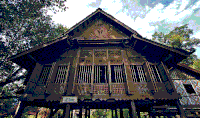Malay houses

Malay houses are traditional homes found in Malaysia and other countries in Southeast Asia. They are designed to keep people cool in the hot and humid climate of the region. The houses are made of wood and have a lot of open spaces to allow for good airflow.
The basic structure of a Malay house is very simple. The walls are made of wooden panels that can be opened or closed depending on the weather. The roof is made of thatched leaves or tiles, and there is often a large veranda or porch on the front of the house.
One of the most distinctive features of a Malay house is the raised platform on which it sits. This is called a "tanah rumah" and it is typically around three feet off the ground. The purpose of this platform is to keep the house dry during floods, which are common in the region.
The inside of a Malay house is also very simple. There are no walls dividing the rooms, so everything is open and airy. The floors are made of wood, and there are usually no chairs or furniture. Instead, people sit on the floor or on cushions called "tikar."
In addition to being functional, Malay houses are also beautiful. They are often decorated with intricate carvings and colorful patterns. The decorations usually have meaning or symbolism, such as the use of floral patterns to represent nature.
Overall, Malay houses are an important part of Southeast Asian culture. They are a symbol of the region's history and traditions, and they continue to be built and lived in today.
The basic structure of a Malay house is very simple. The walls are made of wooden panels that can be opened or closed depending on the weather. The roof is made of thatched leaves or tiles, and there is often a large veranda or porch on the front of the house.
One of the most distinctive features of a Malay house is the raised platform on which it sits. This is called a "tanah rumah" and it is typically around three feet off the ground. The purpose of this platform is to keep the house dry during floods, which are common in the region.
The inside of a Malay house is also very simple. There are no walls dividing the rooms, so everything is open and airy. The floors are made of wood, and there are usually no chairs or furniture. Instead, people sit on the floor or on cushions called "tikar."
In addition to being functional, Malay houses are also beautiful. They are often decorated with intricate carvings and colorful patterns. The decorations usually have meaning or symbolism, such as the use of floral patterns to represent nature.
Overall, Malay houses are an important part of Southeast Asian culture. They are a symbol of the region's history and traditions, and they continue to be built and lived in today.
Related topics others have asked about:
